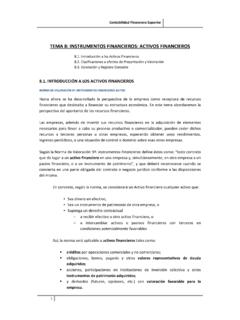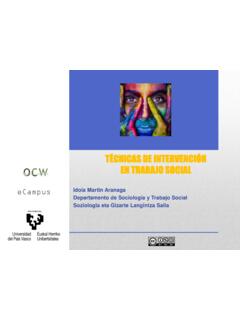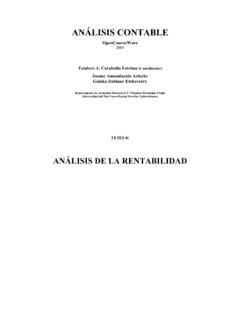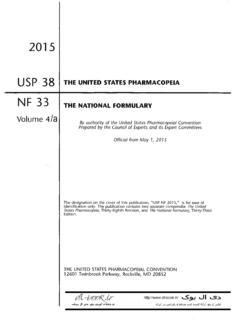Transcription of HOW TO SOLVE PRACTICAL ASPECTS OF MICROBIOLOGY
1 HOW TO SOLVE PRACTICAL ASPECTS OF MICROBIOLOGY 2. BASIC METHODS FOR MICROBIAL enumeration In s Arana, Maite Orru o & Isabel Barcina Department of Immunology, MICROBIOLOGY and Parasitology University of the Basque Country Universidad del Pa s Vasco (UPV/EHU) OCW 2013 2. BASIC METHODS FOR MICROBIAL enumeration There are a number of different methods to enumerate the microorganisms that are present in a given population. Each method has its own peculiarities to transform the data obtained (colony forming units, total microorganisms, ) in microbial density of the sample. A simple method for the enumeration of bacteria and fungi is based on the quantification of colony-forming units (CFU) per ml or g of sample. For this, we must prepare serial dilutions of the sample, plate the diluted suspensions and count the number of colony forming units.
2 Figure 1 shows a scheme of the method. Figure 1. CFU count method scheme. In the previous chapter, we have solved some problems based on the use of this method. However, it should be noted that, normally, 3 or 5 plates per dilution are used. If we perform different decimal dilutions and inoculate more than one plate per dilution, we have different possibilities to interpret the results. It is important that the number of colonies developing on the plates not be too large or too small. The usual practice, which is the most valid statistically, is to count colonies only on plates that have between 30 and 300 colonies. For determining the number of bacteria per mL in the original solution, we have to take into account the average colonies of the selected dilution, the dilution factor and the volume plated.
3 A colonies (average) CFU/ml = X DF (Dilution factor) B volume plated (ml) A ecolonies (average) 1 CFU/ml = X B volume plated (ml) CF (Concentration factor) With the insights acquired in the previous chapter, you should resolve the following problem: Calculate the bacterial density, expressed as CFU/ml, for the three different samples presented in the table. The dilutions used and the number of CFU obtained in each case are also presented in the table. In all cases, the spread volume was 100 l/plate. An interesting question arises when microbial density is below the detection limit, the lowest number of CFU that can be detected by the method used.
4 How must be the results expressed in this situation? Try to SOLVE the following problem: Which is the detection limit of the method if we inoculate 3 plates of a sample with 100 l per plate? A variant of the standard CFU method is the quantification in microdrops. The main differences are that, in this case, the plated volume is lower (usually, 10 or 20 l) and it is not extended in the plate. The method is schematically described in Figure 2. Figure2. Scheme of the microdrop method for CFU count. Sample Dilution Plate 1 Plate 2 Plate 3 1 10-3 1816 1698 1885 10-4 180 159 186 10-5 16 19 10 2 10-2 475 477 480 10-3 45 48 51 10-4 5 10 4 3 100 335 328 324 10-1 32 28 29 10-2 5 3 2 The microdrop method was used to determine the bacterial density of a suspension. The dilutions employed and the results are shown in the table.
5 The plated volume was 10 l. What is the bacterial density of the sample? Another usual technique to enumerate microbes is the Most Probable Number (MPN) method. This is an enumeration method based on the statistic, and it allows estimating the concentration of viable microorganisms in a sample by means of replicate liquid broth growth in serial dilutions. First, decimal dilutions of the sample are prepared and then 1 ml of each dilution is inoculated into 3 broth culture tubes (different numbers of replicates and dilution series can be used). After incubation, tubes are examined for turbidity and those that are positive are recorded for each dilution. For example, if all tubes show growth, the results will be noted as 333. Once the results have been noted, the MPN table (MacGrady table) should be used to determine the most probable number of microorganisms for ml or g.
6 SOLVE the following problems using the MacGrady table attached below. The 1:10 and 1:100 dilutions have been prepared from a water sample. Moreover, 3 sets of 3 tubes were prepared, each containing 10 ml of nutrient broth. The first set of tubes was directly inoculated with the water sample; the second set was inoculated with the 1:10 dilution and the third, with the 1:100 dilution. The inoculated volume was 1 ml in all cases. The tubes were incubated for 48 h at 20 C and, after this period, each tube was examined for turbidity (growth). From the results shown in the table, what is the bacterial density of the water sample? *G = growth = turbidity; NG = not growth = transparent Using the example given above, if growth was not detected in any tube, which would be the bacterial density?
7 Dilution Count 1 Count 2 Count 3 10-3 180 159 186 10-4 16 19 10 Procedure Results* Sample G G G 1:10 Dilution G G G 1:100 Dilution NG G NG MacGrady Table (1 ml/tube, 3 tubes/dilution, 3 ten-fold dilutions). Results expressed as bacteria/ml Number of positive tubes MPN Number of positive tubes NMP Number of positive tubes NMP 000 - 201 302 001 202 310 010 210 311 011 211 312 020 212 313 100 220 320 101 221 321 102 222 322 110 223 323 111 230 330 120 231 331 121 232 332 130 300 333 > 200 301 Other alternatives to determine the total number of microorganisms in a sample are the enumeration methods based in microscopy (photonics, epifluorescence, ..). The relatively large organisms such as yeast or protists can be enumerated using counting chambers (or haemocytometer) (Figure 3).
8 In this procedure, the number of cells in a given volume of liquid culture is counted directly in various microscope fields. The main disadvantage of this method is that usually it is not possible to distinguish between live and dead cells. Figure 3. Some cells counting chambers and scheme to select grids. The different types of counting chambers differ in the counting grids and in the depth of the chambers. The volume of each grid must be known, in order to determine the microbial concentration. Moreover, prior to the enumeration the sample can be diluted or concentrated, so the equations to be used are: Average number of microorganisms/grid Microorganisms/ml = X Dilution factor Grid volume (ml) Average number of microorganisms/grid 1 Microorganisms/ml = X Grid volume (ml) Concentration factor Attention should be given to the units of each factor in the equation.
9 The final result is expressed as number of organisms per volume of sample. To determine the yeast concentration in a dense suspension, this suspension was diluted 1,000 times before preparing the counting chamber. Then, 20 grids were counted and the results were recorded in the table that appears below. If the chamber factor given by the manufacturer is 10-6 ml/grid, could you determine the number of yeasts per ml of suspension? For several decades, epifluorescence microscopy has allowed the visualization and enumeration of microorganisms previously stained with fluorochromes. This is a technique valid for quantification of bacteria (Figure 4). Figure 4. Epifluorescence microscope and image of a sample stained with acridine orange. In order to determine the microbial density in a given sample it is necessary to know the microscope factor (number or fields per filter).
10 The equation used to convert the data into a microbial density is the following one: Grid 1 2 3 4 5 6 7 8 9 10 11 12 13 14 15 16 17 18 19 20 No. cells 12 14 12 11 12 14 15 12 9 11 12 14 15 10 11 9 10 11 12 14 Average number of microorganisms/field Microorganisms/ml = X Microscope factor X Dilution factor Volume filtered (ml) To estimate the bacterial density of a water sample, 100 l of this sample was stained with acridine orange and filtered through a membrane filter of m pore diameter. The filter was mounted on a slide and observed using an epifluorescence microscope. 20 fields were counted and number of bacteria obtained by field was recorded in the following table: If the microscope factor is 30,954 fields/filter, what is the bacterial density of the sample?












